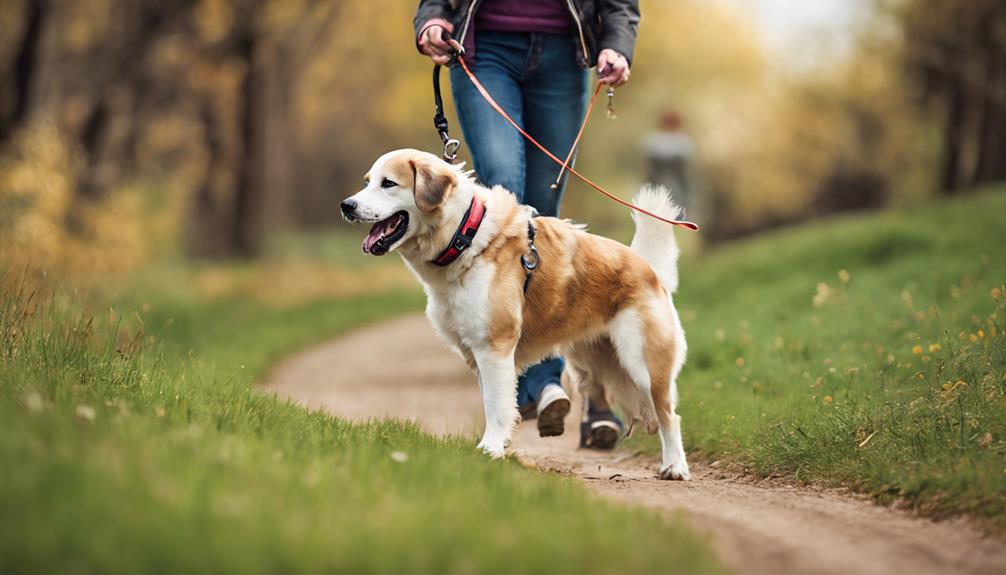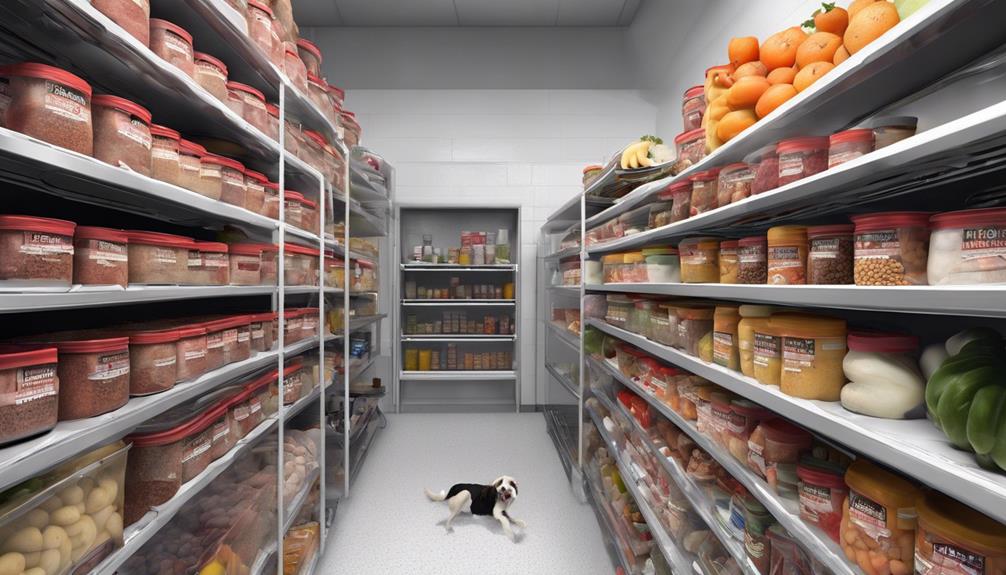Yes, dogs are able to eat cantaloupe. It offers vitamins A and C, hydration, and fiber. However, it is important to be cautious as it may result in weight gain because of its sugar content. Before giving your dog small chunks, make sure to remove the skin, rind, and seeds. Pay attention to ripeness signs such as color, scent, and texture. Consider offering other fruits like blueberries or apples as nutritious alternatives. Interested in learning more about incorporating fruits and vegetables into your dog’s diet?
Key Takeaways
- Rich in vitamins A and C, safe for dogs in moderation.
- Remove skin, seeds, and rind to prevent digestive issues.
- High water content aids hydration and supports digestion.
- Potential risks include high sugar content and allergies.
- Choose ripe cantaloupe, cut into small pieces for safe feeding.
Health Benefits of Cantaloupe for Dogs
Cantaloupe offers dogs essential hydration and fiber, aiding in digestion and providing a rich source of vitamins and antioxidants. Dogs can enjoy the health benefits of this delicious fruit as it's safe for them to eat.
The high water content in cantaloupe helps keep our furry friends hydrated, especially during hot days or after vigorous activities. The fiber present in cantaloupe promotes healthy digestion in dogs, preventing any tummy troubles they may encounter.
Additionally, the nutrients such as vitamin A, B6, C, niacin, folate, and potassium found in cantaloupe contribute to overall well-being. These vitamins help support their immune system, vision, skin, and coat health. The antioxidants in cantaloupe play a vital role in maintaining healthy cell function and slowing down the aging process in dogs.
Risks of Feeding Cantaloupe to Dogs

After discussing the health benefits of cantaloupe for dogs, it is important to now address the potential risks associated with feeding this fruit to our furry companions. When considering whether dogs can eat cantaloupe, it's crucial to be aware of the risks involved. Cantaloupe is high in sugar, making it unsuitable for diabetic or overweight dogs. The excessive fiber content in cantaloupe can also cause gastrointestinal upset in some dogs. To mitigate these risks, it is advisable to remove the seeds before feeding cantaloupe to your dog. Additionally, some dogs may have allergic reactions or intolerances to cantaloupe, leading to symptoms like vomiting, diarrhea, or lethargy. If you notice any adverse effects after your dogs eat cantaloupe, it's essential to stop feeding them this fruit and consult your veterinarian for guidance.
| Risks Associated with Feeding Cantaloupe to Dogs |
|---|
| High in sugar |
| Cause gastrointestinal upset |
| Allergic reactions |
| Excessive fiber |
| Symptoms: vomiting, diarrhea, lethargy |
Safe Ways to Feed Cantaloupe
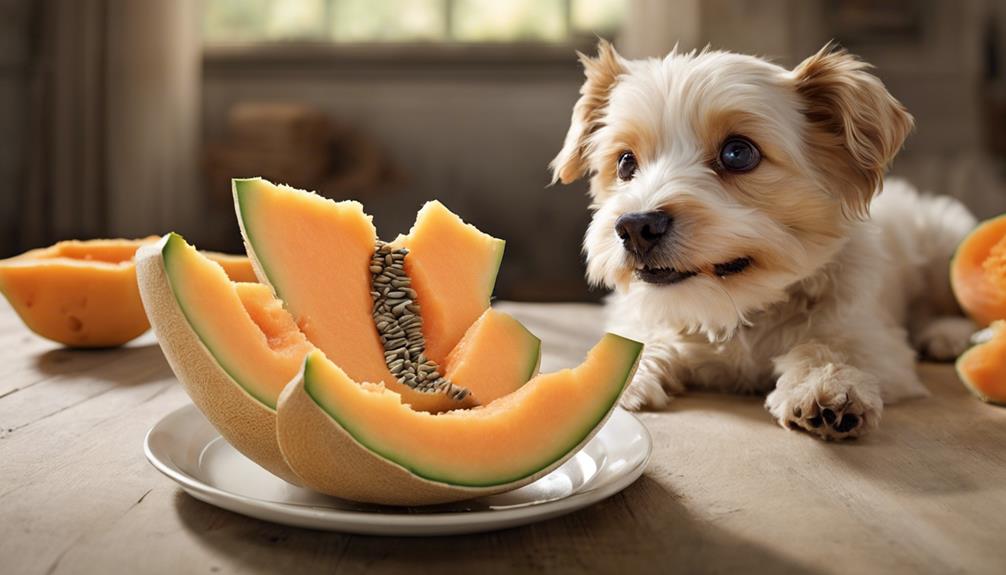
When offering cantaloupe to dogs, it's essential to remove the skin, rind, and seeds to prevent any potential issues.
Cutting the cantaloupe into small, manageable chunks makes it easier for dogs to chew and digest.
Serving Size for Dogs
For safe consumption by dogs, it is recommended to cut cantaloupe into small, 1/2-inch pieces and remove the skin and seeds before feeding. Cantaloupe is good for dogs in small amounts due to its high water content, making it a safe and occasional treat. To help you understand the suitable serving size for your furry friend, here is a helpful table:
| Dog Size | Cantaloupe Serving Size |
|---|---|
| Small | 1-2 pieces |
| Medium | 2-3 pieces |
| Large | 3-4 pieces |
| Extra Large | 4-5 pieces |
| Giant Breeds | 5-6 pieces |
Potential Health Benefits
To guarantee your dog benefits from the hydration, fiber, and essential vitamins in cantaloupe, it's important to feed them small, prepared portions while removing the skin and seeds. Cantaloupe is good for dogs due to its high water content and nutrient profile.
Remember to remove the rind and seeds before offering this tasty treat to your furry friend. Cutting the cantaloupe into small chunks ensures safe consumption.
While cantaloupe can be a healthy snack, feeding your dog too much can cause gastrointestinal issues. By following these guidelines and offering cantaloupe in moderation, you can provide your dog with a delicious and nutritious treat that supports their overall well-being.
How to Pick Ripe Cantaloupe
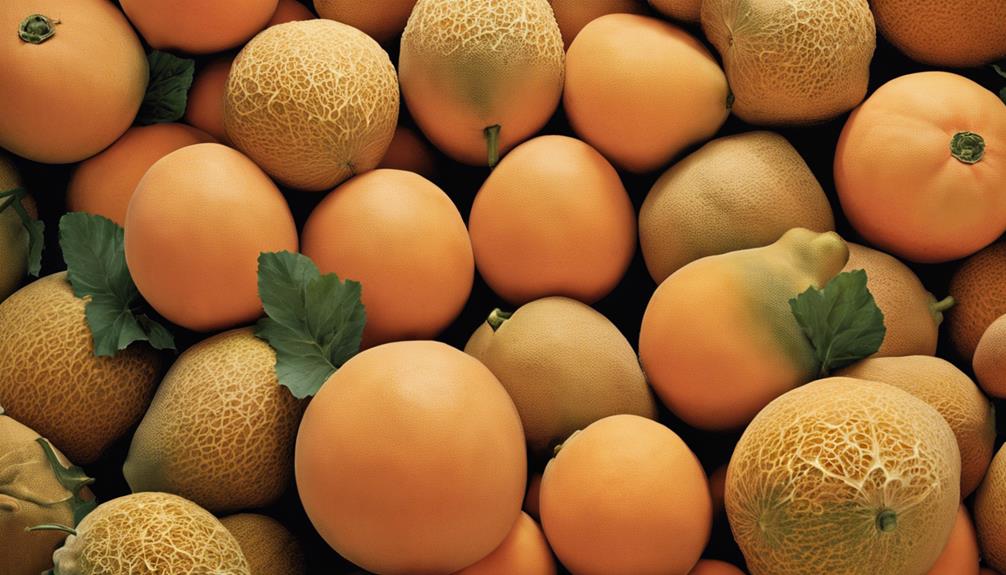
When selecting a ripe cantaloupe, pay attention to its color, scent, and texture.
Look for a vibrant golden or orange hue, a sweet, musky fragrance, and a firm, unyielding feel.
These indicators will guide us in choosing the perfect cantaloupe for our furry friends to enjoy.
Cantaloupe Ripeness Indicators
Sniffing the sweet, musky scent of a cantaloupe is the first step to determining its ripeness for consumption. A ripe cantaloupe will have a pleasant aroma that signals it's ready to eat. Check for a detached stem, as this is a good indicator of ripeness.
When selecting a cantaloupe, make sure it feels firm without any soft spots or bruising, which could mean it's overripe. Remember, ripe cantaloupes contain more sugar, so it's crucial to feed them to dogs in moderation.
Before offering cantaloupe to your furry friend, remove the seeds and rind as these parts can be a choking hazard. By following these indicators, you can pick a ripe cantaloupe that your dog will enjoy.
Color and Scent Test
By examining both the color and scent, one can easily determine the ripeness of a cantaloupe. A ripe cantaloupe will give off a sweet, musky scent, signaling that it's good to eat. Look for a cantaloupe with a high-contrast skin color – a small area of a lighter color where it sat on the ground is a good indicator of ripeness.
When you gently press the stem end, it should yield slightly but not be too soft. Remember to remove the seeds and rind before feeding cantaloupe to dogs – this small treat can be a much-loved snack for them. Always consider moderation when treating your furry friend with cantaloupe to avoid feeding them too much sugar.
Texture and Firmness
To select a ripe cantaloupe with ideal texture and firmness, look for a fruit that feels heavy for its size and yields slightly when gently pressed. A ripe cantaloupe should have a sweet, musky scent, indicating its readiness for consumption. Make sure the cantaloupe is firm without soft spots or bruising for best taste and texture.
Remember, ripe cantaloupes have higher sugar content, so feed them to dogs in moderation. Always remove the seeds and rind before offering cantaloupe to dogs to prevent choking hazards.
Preparing Cantaloupe for Dogs
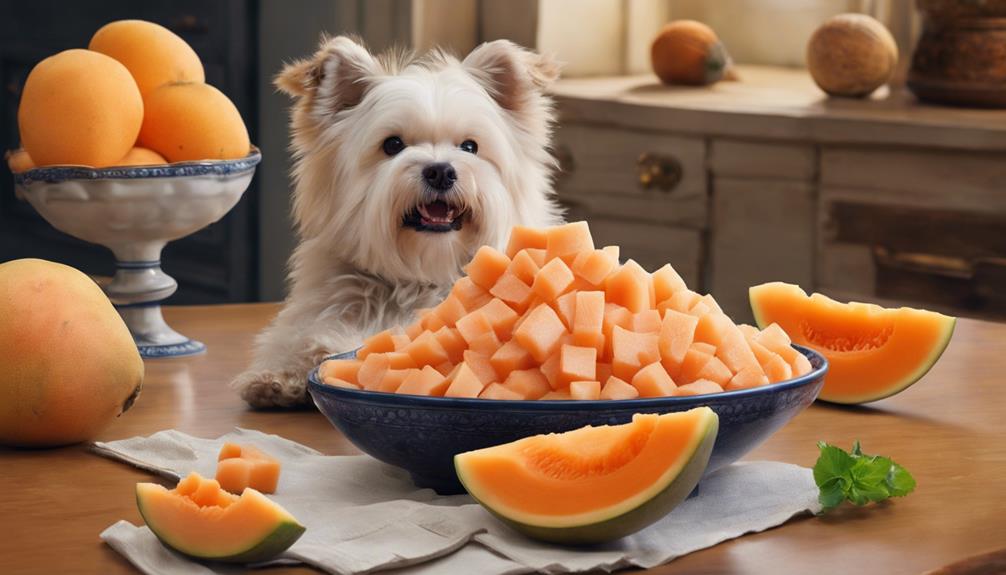
When preparing cantaloupe for dogs, it's essential to eliminate the skin, rind, and seeds to guarantee safe consumption. The tough skin and seeds can be challenging for dogs to digest and may pose gastrointestinal issues or choking hazards.
Cantaloupe seeds are particularly problematic, so make sure to remove all of them before offering this fruit to your furry friend. Additionally, cutting the cantaloupe into small, dog-friendly pieces will help your pet enjoy it without any issues.
This sweet fruit is a great source of nutrients and has a high water content, making it a healthy treat option for your dog. By properly preparing the cantaloupe and ensuring it's free of any toxic parts, you can safely introduce this delicious snack into your dog's diet.
Other Melon Products for Dogs
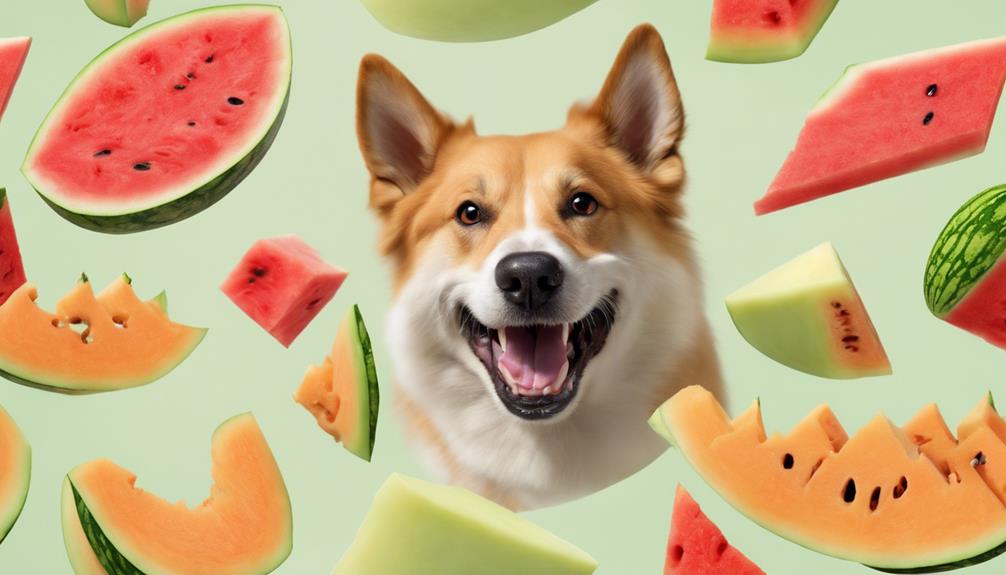
Exploring a variety of melon products can provide dogs with nutritious and tasty options for treats. When selecting fruit choices for your furry friend, it's vital to choose natural treats to make sure they receive the essential nutrients without any artificial ingredients. Here is a table showcasing some safe fruits that can be part of your dog's balanced diet:
| Safe Fruits | Benefits |
|---|---|
| Cantaloupe | Rich in vitamins A and C, hydrating. |
| Watermelon | High water content, invigorating. |
| Honeydew | Low in calories, high in fiber. |
| Blueberries | Antioxidant-rich, great for cognitive health. |
| Apples | Source of vitamin C and fiber. |
Remember to avoid toxic foods like mushrooms and ensure the melon products are free from added sugar or sweeteners. By incorporating these safe fruits into your dog's diet, you can provide them with a variety of natural and healthy treats that contribute to their overall well-being.
Frequently Asked Questions
How Much Cantaloupe Can a Dog Eat?
We suggest offering cantaloupe as no more than 10% of your dog's diet to prevent gastrointestinal issues from excessive fiber. Vitality is essential when feeding cantaloupe to your furry friend.
Consider the high sugar content if your dog is diabetic or overweight. If unsure, consult a veterinarian before adding cantaloupe to your dog's menu.
Are Any Melons Toxic to Dogs?
Melons, including cantaloupe, are typically safe for dogs. However, it's crucial to eliminate seeds and rind before giving them to your furry companion.
Cantaloupe can offer hydration and vital nutrients to dogs when provided in moderation. If you have worries about feeding cantaloupe or any other melon to your dog, seeking advice from a vet is always a good idea to guarantee their health and well-being.
Can Dogs Eat Cantaloupe With Skin?
Yes, dogs can consume cantaloupe, but it's crucial to eliminate the skin first. Retaining the skin can be challenging for their digestion and present a choking risk.
To keep your furry companion safe, always slice the cantaloupe into small, skinless pieces before giving it to them. This simple step helps avoid any potential digestive problems and guarantees your dog can relish this delicious treat without any harm.
What Melon Is Best for Dogs?
Cantaloupe is the best melon for dogs. It's packed with water and essential vitamins like A, B, and C. Dogs benefit from the fiber and hydration it provides, especially in hot weather.
Additionally, cantaloupe is low in calories, making it a healthy snack choice. To keep your pup safe, always remove the seeds and rind before feeding them cantaloupe.
It's a delicious and nutritious treat that your furry friend will enjoy!
Conclusion
To sum up, dogs can safely enjoy cantaloupe in moderation, as it offers a variety of health benefits including vitamins, minerals, and hydration. However, it's essential to be mindful of the potential risks associated with feeding cantaloupe, such as choking hazards and digestive issues.
When selecting and preparing cantaloupe for your four-legged companion, always prioritize their safety and well-being. Keep in mind that only around 10% of a dog's diet should comprise fruits like cantaloupe to ensure a balanced and nutritious diet.



